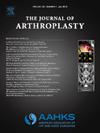Is Hospital-Based Outpatient Revision Total Knee Arthroplasty Safe? An Analysis of 2,171 Outpatient Aseptic Revision Procedures
IF 3.4
2区 医学
Q1 ORTHOPEDICS
引用次数: 0
Abstract
Background
Outpatient primary total knee arthroplasty (TKA) has been well-established as a safe and effective procedure; however, the safety of outpatient revision TKA remains unclear. Therefore, this study utilized a large database to compare outcomes between outpatient and inpatient revision TKA.
Methods
An all-payor database was queried to identify patients undergoing revision TKA from 2010 to 2022. Patients who had diagnosis codes related to periprosthetic joint infection (PJI) were excluded. Outpatient surgery was defined as a length of stay < 24 hours. Cohorts were matched by age, sex, Elixhauser Comorbidity Index, comorbidities (diabetes, obesity, tobacco use), components revised (1-versus 2-component), and revision etiology. Medical complications at 90 days and surgical complications at 1 and 2 years postoperatively were evaluated through multivariate logistic regression. A total of 4,342 aseptic revision TKAs were included.
Results
No differences in patient characteristics, procedure type, or revision etiologies were seen between groups. The outpatient cohort had a lower risk of PJI (odds ratio (OR): 0.547, 95% confidence interval (CI): 0.337 to 0.869; P = .012), wound dehiscence (OR: 0.393, 95% CI: 0.225 to 0.658; P < .001), transfusion (OR: 0.241, 95% CI: 0.055 to 0.750; P = .027), reoperation (OR: 0.508, 95% CI: 0.305 to 0.822; P = .007), and any complication (OR: 0.696, 95% CI: 0.584 to 0.829; P < .001) at 90 days postoperatively. At 1 year and 2 years postoperatively, outpatient revision TKA patients had a lower incidence of revision for PJI (OR: 0.332, 95% CI: 0.131 to 0.743; P = .011 and OR: 0.446, 95% CI; 0.217 to 0.859; P = .020, respectively) and all-cause revision (OR: 0.518, 95% CI: 0.377 to 0.706; P < .001 and OR: 0.548, 95% CI: 0.422 to 0.712; P < .001, respectively).
Conclusions
Our findings suggest that revision TKA can be safely performed on an outpatient basis in appropriately selected patients who do not have an increased risk of adverse events relative to inpatient revision TKA. However, we could not ascertain case complexity in either cohort, and despite controlling for several potential confounders, other less tangible differences could exist between groups.
医院门诊翻修全膝关节置换术安全吗?对 2,171 例门诊无菌翻修手术的分析。
导言:门诊初级全膝关节置换术(TKA)作为一种安全有效的手术已得到广泛认可,但门诊翻修TKA的安全性仍不明确。因此,本研究利用大型数据库对门诊患者和住院患者翻修后 TKA 的疗效进行了比较:方法: 查询了所有付费者数据库,以确定 2010 年至 2022 年期间接受翻修 TKA 的患者。排除了有假体周围感染(PJI)相关诊断代码的患者。门诊手术的定义是住院时间小于 24 小时。根据年龄、性别、Elixhauser 生病指数 (ECI)、合并症(糖尿病、肥胖、吸烟)、翻修组件(单组件与双组件)和翻修病因对组群进行匹配。通过多变量逻辑回归评估了术后 90 天的医疗并发症和术后 1 年和 2 年的手术并发症。共纳入了4342例无菌翻修TKAs:结果:两组患者在特征、手术类型或翻修病因方面均无差异。门诊患者组发生假体周围关节感染(PJI)的风险较低(OR[几率比]:0.547,95% C%):0.547,95% CI [置信区间]:0.337至0.869;P = 0.012)、伤口开裂(OR:0.393,95% CI:0.225至0.658;P <0.001)、输血(OR:0.241,95% CI:0.055至0.750;P = 0.027)、再次手术(OR:0.508,95% CI:0.305 至 0.822;P = 0.007)和术后 90 天的任何并发症(OR:0.696,95% CI:0.584 至 0.829;P < 0.001)。术后 1 年和 2 年,门诊翻修 TKA 患者因 PJI 而翻修的发生率较低(OR:0.332,95% CI:0.131 至 0.743;P = 0.011 和 OR:0.446,95% CI;0.217至0.859;P=0.020)和全因翻修(OR:0.518,95% CI:0.377至0.706;P<0.001和OR:0.548,95% CI:0.422至0.712;P<0.001):我们的研究结果表明,经过适当选择的患者可以在门诊安全地进行翻修TKA,与住院翻修TKA相比,这些患者发生不良事件的风险不会增加。然而,我们无法确定两组患者的病例复杂程度,而且尽管控制了几个潜在的混杂因素,两组患者之间可能还存在其他不太明显的差异。
本文章由计算机程序翻译,如有差异,请以英文原文为准。
求助全文
约1分钟内获得全文
求助全文
来源期刊

Journal of Arthroplasty
医学-整形外科
CiteScore
7.00
自引率
20.00%
发文量
734
审稿时长
48 days
期刊介绍:
The Journal of Arthroplasty brings together the clinical and scientific foundations for joint replacement. This peer-reviewed journal publishes original research and manuscripts of the highest quality from all areas relating to joint replacement or the treatment of its complications, including those dealing with clinical series and experience, prosthetic design, biomechanics, biomaterials, metallurgy, biologic response to arthroplasty materials in vivo and in vitro.
 求助内容:
求助内容: 应助结果提醒方式:
应助结果提醒方式:


